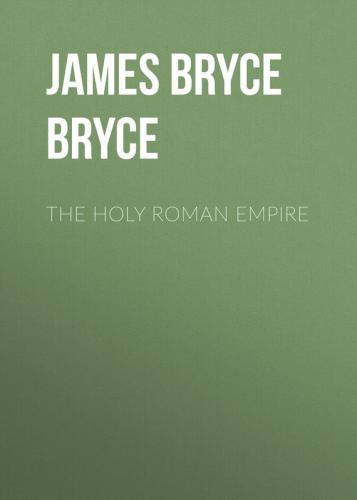78
Engilenheim, or Ingelheim, lies near the left shore of the Rhine between Mentz and Bingen.
79
Eginhard,
80
Eginhard,
81
It is not a little curious that of the three whom the modern French have taken to be their national heroes all should have been foreigners, and two foreign conquerors.
82
This basilica was built upon the model of the church of the Holy Sepulchre at Jerusalem, and as it was the first church of any size that had been erected in those regions for centuries past, it excited extraordinary interest among the Franks and Gauls. In many of its features it greatly resembles the beautiful church of San Vitale, at Ravenna (also modelled upon that of the Holy Sepulchre) which was begun by Theodoric, and completed under Justinian. Probably San Vitale was used as a pattern by Charles's architects: we know that he caused marble columns to be brought from Ravenna to deck the church at Aachen. Over the tomb of Charles, below the central dome (to which the Gothic choir we now see was added some centuries later), there hangs a huge chandelier, the gift of Frederick Barbarossa.
83
'Romuleum Francis præstitit imperium.' – Elegy of Ermoldus Nigellus, in Pertz;
84
Usage has established this translation of 'Hludowicus Pius,' but 'gentle' or 'kind-hearted' would better express the meaning of the epithet.
85
Von Ranke discovers in this early traces of the aversion of the Germans to the pretensions of the spiritual power. —
86
Singularly enough, when one thinks of modern claims, the dynasty of France (Francia occidentalis) had the least share of it. Charles the Bald was the only West Frankish Emperor, and reigned a very short time.
87
Tac.
88
For an account of the various applications of the name Burgundy, see Appendix, Note A.
89
The accession of Boso took place in A.D. 877, eleven years before Charles the Fat's death. But the new kingdom could not be considered legally settled until the latter date, and its establishment is at any rate a part of that general break-up of the great Carolingian empire whereof A.D. 888 marks the crisis. See Appendix A at the end.
It is a curious mark of the reverence paid to the Carolingian blood, that Boso, a powerful and ambitious prince, seems to have chiefly rested his claims on the fact that he was husband of Irmingard, daughter of the Emperor Lewis II. Baron de Gingins la Sarraz quotes a charter of his (drawn up when he seems to have doubted whether to call himself king) which begins, 'Ego Boso Dei gratia id quod sum, et coniux mea Irmingardis proles imperialis.'
90
Lewis had been surprised by Berengar at Verona, blinded, and forced to take refuge in his own kingdom of Provence.
91
Alberic is called variously senator, consul, patrician, and prince of the Romans.
92
Adelheid was daughter of Rudolf, king of Trans-Jurane Burgundy. She was at this time in her nineteenth year.
93
94
See especially the poem of Florus the Deacon (printed in the Benedictine collection and in Migne), a bitter lament over the dissolution of the Carolingian Empire. It is too long for quotation. I give four lines here: —
95
Witukind,
96
Cf. esp. the '
97
'Licet videamus Romanorum regnum in maxima parte jam destructum, tamen quamdiu reges Francorum duraverint qui Romanum imperium tenere debent, dignitas Romani imperii ex toto non peribit, quia stabit in regibus suis.' —
98
From the money which Otto struck in Italy, it seems probable that he did occasionally use the title of king of Italy or of the Lombards. That he was crowned can hardly be considered quite certain.
99
'A papa imperator ordinatur,' says Hermannus Contractus. 'Dominum Ottonem, ad hoc usque vocatum regem, non solum Romano sed et pœne totius Europæ populo acclamante imperatorem consecravit Augustum.' —
100
I do not mean to say that the system of ideas which it is endeavoured to set forth in the following pages was complete in this particular form, either in the days of Charles or in those of Otto, or in those of Frederick Barbarossa. It seems to have been constantly growing and decaying from the fourth century to the sixteenth, the relative prominence of its cardinal doctrines varying from age to age. But, just as the painter who sees the ever-shifting lights and shades play over the face of a wide landscape faster than his brush can place them on the canvas, in despair at representing their exact position at any single moment, contents himself with painting the effects that are broadest and most permanent, and at giving rather the impression which the scene makes on him than every detail of the scene itself, so here, the best and indeed the only practicable course seems to be that of setting forth in its most self-consistent form the body of ideas and beliefs on which the Empire rested, although this form may not be exactly that which they can be asserted to have worn in any one century, and although the illustrations adduced may have to be taken sometimes from earlier, sometimes from later writers. As the doctrine of the Empire was in its essence the same during the whole Middle Age, such a general description as is attempted here may, I venture to hope, be found substantially true for the tenth as well as for the fourteenth century.
101
Empires like the Persian did nothing to assimilate the subject races, who retained their own laws and customs, sometimes their own princes, and were bound only to serve in the armies and fill the treasury of the Great King.
102
Od. iii. 72: —
Cf. Od. ix. 39: and the Hymn to the Pythian Apollo, I. 274. So in II. v. 214, ἀλλότριος φώς.
103
Plato, in the beginning of the Laws, represents it as natural between all states: πολεμὸς φύσει ὑπάρχει πρὸς ἁπάσας τὰς πόλεις.
104
See especially Acts xvii. 26; Gal. iii.
